成骨细胞与破骨细胞共培养及其应用研究进展
成骨与破骨细胞作用机制

成骨与破骨细胞作用机制骨骼是人体一种重要的组织,但骨骼组织并非是固定不变的,它经常遭受到破坏和再生。
这个过程主要是由成骨与破骨细胞所完成的。
本文将围绕成骨和破骨细胞的作用机制和相互作用过程进行分析。
1.成骨细胞的作用机制成骨细胞是一种具有分泌骨基质和维持骨骼结构稳定性的功能。
成骨细胞可以合成并分泌骨基质,它们促使钙等矿物质沉积在骨的表面,并通过这种方式将骨骼组织加强。
此外,成骨细胞还可以对骨骼进行维修,将不健康或受损的骨细胞从其位置取出。
然后释放生长因子并将新的骨细胞放置在受损位置进行修复。
现有的研究表明,成骨细胞在钙和维生素D的影响下会分化为成骨细胞前体细胞并发生分化和成熟,从而具有骨形态的因素和功能性特征。
2.破骨细胞的作用机制破骨细胞起到了分解和破坏骨匡骨基质的作用。
破骨细胞通过胞吞作用,将骨骼组织中的碎片吞噬并去除出来。
这些骨骼碎片随后会被破骨细胞消化吸收。
这种过程促使骨骼组织发生了断裂,同时也释放了一些生长因子,从而吸引成骨细胞维修和加强这个部位的骨骼。
此外,破骨细胞会分泌一些化学物质,如细胞因子和生长因子,以帮助成骨细胞进一步发挥作用。
破骨细胞由多核苷细胞所组成,具有对骨组织的具体方向、密度和硬度进行微调的功能。
3.成骨和破骨细胞作用机制骨骼组织的更新是通过成骨和破骨细胞之间的相互作用来实现的。
在一篇品质极好的研究文章中发现,当骨骼组织遭到损害时,破骨细胞率先出击并分解掉受打击的组织,从而释放出生长因子以吸引成骨细胞进行修复。
成骨细胞会依靠生长因子和化学物质在破骨细胞去除骨骼碎片后,对骨基质进行修复。
因此,成骨细胞和破骨细胞相互周期性作用,为骨骼组织的持续更新和维修提供支持。
综上所述,成骨细胞和破骨细胞是骨骼维修和再生的主要力量。
成骨细胞负责维护骨骼组织的稳定性和强度,而破骨细胞用于分解受损的骨骼组织并释放生长因子以吸引成骨细胞进行修复。
在此过程中,成骨和破骨细胞将会得到化学物质和生长因子的互相配合,从而构成了一个复杂的调节和控制系统。
成骨细胞与破骨细胞的研究探讨
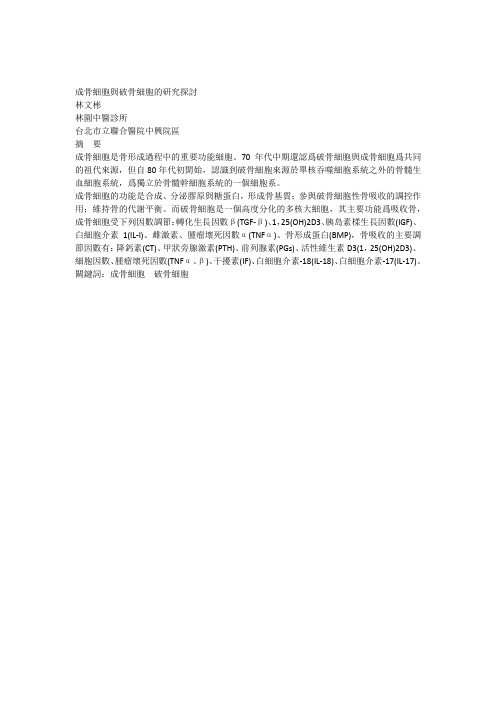
成骨細胞與破骨細胞的研究探討林文彬林園中醫診所台北市立聯合醫院中興院區摘要成骨細胞是骨形成過程中的重要功能細胞。
70年代中期還認爲破骨細胞與成骨細胞爲共同的祖代來源,但自80年代初開始,認識到破骨細胞來源於單核吞噬細胞系統之外的骨髓生血細胞系統,爲獨立於骨髓幹細胞系統的一個細胞系。
成骨細胞的功能是合成、分泌膠原與糖蛋白,形成骨基質;參與破骨細胞性骨吸收的調控作用;維持骨的代謝平衡。
而破骨細胞是一個高度分化的多核大細胞,其主要功能爲吸收骨,成骨細胞受下列因數調節:轉化生長因數β(TGF-β)、1,25(OH)2D3、胰島素樣生長因數(IGF)、白細胞介素1(IL-I)、雌激素、腫瘤壞死因數α(TNFα)、骨形成蛋白(BMP),骨吸收的主要調節因數有:降鈣素(CT)、甲狀旁腺激素(PTH)、前列腺素(PGs)、活性維生素D3(1,25(OH)2D3)、細胞因數、腫瘤壞死因數(TNFα、β)、干擾素(IF)、白細胞介素-18(IL-18)、白細胞介素-17(IL-17)。
關鍵詞:成骨細胞破骨細胞前言骨質疏鬆症是骨吸收與骨形成之間的平衡被打破,骨吸收佔優勢而使骨量減少,成骨細胞和破骨細胞是骨組織特有的兩種細胞,在激素及細胞因數等作用下作用於骨,是骨代謝過程中的重要核心細胞。
故對成骨及破骨細胞的研究,對於理解骨質疏鬆的發病及藥物的療效都具有重要意義。
成骨細胞及破骨細胞的來源(一)成骨細胞的來源成骨細胞(Osteoblast OB)是骨形成過程中的重要功能細胞。
成骨細胞的主要功能是分泌骨基質(包括膠原與糖蛋白)及進行合成。
其分泌的膠原95%爲I型膠原蛋白(1)。
此外還有少量的Ⅲ型、IV型及V型膠原,可見於小鼠、雞和人胚的成骨細胞。
成骨細胞還參與破骨細胞性骨吸收的調節,兩者是骨代謝過程中的重要核心細胞。
成骨細胞的起源,經大量研究現己公認:成骨細胞來源於末分化的多潛能幹細胞,這種幹細胞具有分化爲多種細胞類型的特徵,在各種調控因數的作用下,通過複雜的分子機制,間充質多潛能幹細胞可以分化爲成骨細胞、成纖維細胞、脂肪細胞以及肌細胞等。
破骨细胞及其骨吸收调控研究进展.

破骨细胞及其骨吸收调控研究进展一、概述破骨细胞是一个高度分化的多核巨细胞,直接参与骨吸收,是骨组织吸收的主要功能细胞。
破骨细胞的来源:由于长期以来对于破骨细胞(Osteoclast,OC)的来源问题一直不清楚,给研究工作带来许多困难,因而对临床各种骨疾患的诊断及其防治水平,也不可能进一步深入和提高。
对于破骨细胞来源的认识,在本世纪40~70年代,普遍应用的经典理论为多潜能的骨源细胞学说,认为破骨细胞是由骨源细胞融合而成。
直至70年代中期还认为OC与成骨细胞(OB)为共同的祖代来源。
这种观点多年来一直是疑问,不能被证实,现已被否定。
自80年代初开始,提出了OC来源于骨外生血系统,自此又出现了3种不同观点:(1)OC源于单核吞噬细胞系统,即由单核细胞融合而成,这一观点现已被否定。
(2)OC与单核吞噬细胞共同来源于骨髓生血系统的同一前身细胞,之后各自向不同方向分化。
这一假说也被实验研究所推翻。
研究表明,由骨髓而来的单核细胞经培养之后,可以分化为破骨细胞,但是末梢血中的单核细胞与腹腔中的单核巨噬细胞,经培养后并不能形成破骨细胞,而且前者与破骨细胞的细胞膜上有不同的表面抗原,这提示了破骨细胞与单核巨噬细胞两者不是来自共同的祖代。
(3)OC来源于单核吞噬细胞系统之外的骨髓生血细胞系统,为独立于骨髓干细胞系统的一个细胞系。
Walker曾采用患有硬化病的小鼠及正常小鼠进行了血循联体实验,结果患硬化病的小鼠恢复了正常。
研究表明,破骨细胞浆中碳酸酐酶Ⅱ(CAⅡ)基因突变可以引起骨硬化病的发生。
由此表明,破骨细胞是来源于正常鼠的骨髓生血系统。
此外,在临床上通过对患石骨症的患者移植整个胸腺、骨髓等,也取得了良好的疗效。
由此说明,破骨细胞的形成取决于血循中的细胞。
OC在胚胎早期就已到达骨膜,再逐渐分化、融合为破骨细胞,也就是说OC的前驱细胞是前破骨细胞(Proosteoclast),它在胚胎期间已存在于骨的微环境中,到达骨膜后,由前破骨细胞分化、融合为破骨细胞。
Toll样受体4在成骨细胞共培养体系中对干细胞向破骨细胞分化的影响及机制中期报告
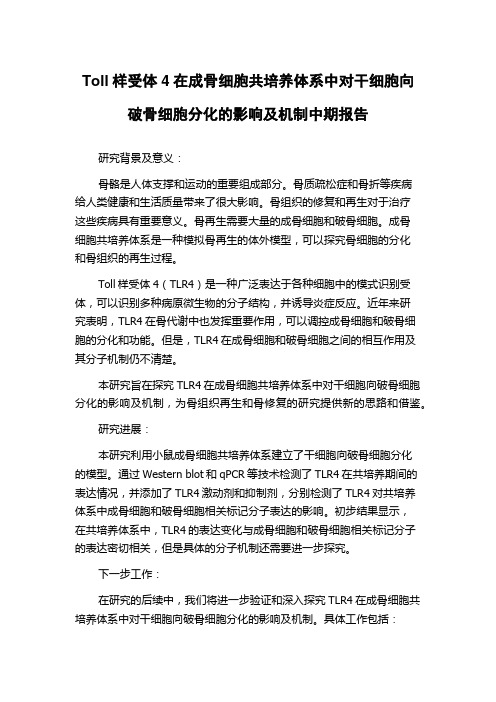
Toll样受体4在成骨细胞共培养体系中对干细胞向破骨细胞分化的影响及机制中期报告研究背景及意义:骨骼是人体支撑和运动的重要组成部分。
骨质疏松症和骨折等疾病给人类健康和生活质量带来了很大影响。
骨组织的修复和再生对于治疗这些疾病具有重要意义。
骨再生需要大量的成骨细胞和破骨细胞。
成骨细胞共培养体系是一种模拟骨再生的体外模型,可以探究骨细胞的分化和骨组织的再生过程。
Toll样受体4(TLR4)是一种广泛表达于各种细胞中的模式识别受体,可以识别多种病原微生物的分子结构,并诱导炎症反应。
近年来研究表明,TLR4在骨代谢中也发挥重要作用,可以调控成骨细胞和破骨细胞的分化和功能。
但是,TLR4在成骨细胞和破骨细胞之间的相互作用及其分子机制仍不清楚。
本研究旨在探究TLR4在成骨细胞共培养体系中对干细胞向破骨细胞分化的影响及机制,为骨组织再生和骨修复的研究提供新的思路和借鉴。
研究进展:本研究利用小鼠成骨细胞共培养体系建立了干细胞向破骨细胞分化的模型。
通过Western blot和qPCR等技术检测了TLR4在共培养期间的表达情况,并添加了TLR4激动剂和抑制剂,分别检测了TLR4对共培养体系中成骨细胞和破骨细胞相关标记分子表达的影响。
初步结果显示,在共培养体系中,TLR4的表达变化与成骨细胞和破骨细胞相关标记分子的表达密切相关,但是具体的分子机制还需要进一步探究。
下一步工作:在研究的后续中,我们将进一步验证和深入探究TLR4在成骨细胞共培养体系中对干细胞向破骨细胞分化的影响及机制。
具体工作包括:1. 进一步检测TLR4在共培养体系中的表达动态变化,探究TLR4是否可以调控成骨细胞和破骨细胞的分化和功能;2. 利用TLR4基因敲除小鼠或TLR4拮抗剂等方法,进一步验证TLR4在共培养体系中的作用,并探究其下游信号通路的调控机制;3. 通过小鼠骨折模型等体内实验,验证TLR4在骨组织修复和再生中的重要性,为骨组织再生和骨修复提供新的靶点和策略。
成骨细胞的研究与应用
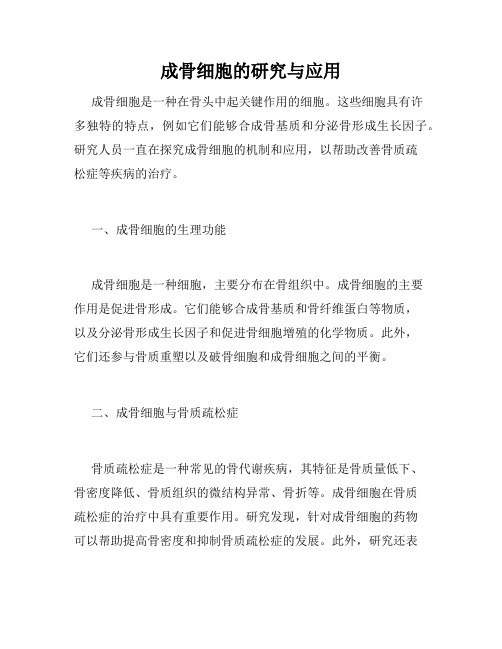
成骨细胞的研究与应用成骨细胞是一种在骨头中起关键作用的细胞。
这些细胞具有许多独特的特点,例如它们能够合成骨基质和分泌骨形成生长因子。
研究人员一直在探究成骨细胞的机制和应用,以帮助改善骨质疏松症等疾病的治疗。
一、成骨细胞的生理功能成骨细胞是一种细胞,主要分布在骨组织中。
成骨细胞的主要作用是促进骨形成。
它们能够合成骨基质和骨纤维蛋白等物质,以及分泌骨形成生长因子和促进骨细胞增殖的化学物质。
此外,它们还参与骨质重塑以及破骨细胞和成骨细胞之间的平衡。
二、成骨细胞与骨质疏松症骨质疏松症是一种常见的骨代谢疾病,其特征是骨质量低下、骨密度降低、骨质组织的微结构异常、骨折等。
成骨细胞在骨质疏松症的治疗中具有重要作用。
研究发现,针对成骨细胞的药物可以帮助提高骨密度和抑制骨质疏松症的发展。
此外,研究还表明,成骨细胞的数量和功能的下降是骨质疏松症发生的一个重要原因。
三、成骨细胞与骨折愈合成骨细胞在骨折愈合中起关键作用。
在骨受到损伤后,成骨细胞会通过旁分泌的骨形成因子和生长因子等分泌物质来引导骨生长和修复。
研究人员还在探索利用成骨细胞在骨科手术、骨折愈合和骨移植等方面的应用。
四、成骨细胞在组织工程方面的应用成骨细胞在组织工程方面也具有广阔的应用前景。
组织工程是一种将生物学、医学和工程学方法相结合,利用体外培养细胞和人工材料等技术来重建人体组织的方法。
利用成骨细胞,研究人员可以在体外进行组织工程构建,制造出具有骨质结构和功能的三维复合结构,该技术可以应用于骨再生和骨移植等方面。
总之,成骨细胞在骨组织中具有非常重要的作用,其机制与功能的研究和应用可以帮助我们更好地理解骨生长和疾病的发生发展。
未来,我们相信,随着对成骨细胞的深入研究,我们会创造出更多的医学应用和发展前景。
成骨细胞与破骨细胞的共培养体系

成骨细胞与破骨细胞的共培养体系
1 建立成骨细胞与破骨细胞共培养体系
成骨细胞和破骨细胞是骨再生的重要细胞,在成骨和破骨之间存
在矛盾性相互作用,为解决该矛盾性作用,建立成骨细胞与破骨细胞
共培养体系是有必要的。
1.1 获取细胞
获取成骨细胞和破骨细胞是共培养体系的第一步。
一般的获取方
式有从动物原位骨组织采集、从动物移植位骨组织采集以及从动物分
化出的骨细胞培养采集等;此外,还可以利用旁路移植操作获得成骨
和破骨细胞,以及通过多剂量胶原纤维骨再生制备法获取到成骨细胞,以及经过分离纯化的单个样品。
1.2 制备培养基
共培养体系建立的必要组成部分之一是,必须将对成骨细胞和破
骨细胞培养基进行优化;即构建一个基于实验的的多层联合的培养体系。
1.3 实现活细胞共培养
实现活细胞共培养仅用AMP法是不能取得理想效果的,而且很容
易造成细胞成骨破骨细胞凋亡和发生假复合,因此需要考虑利用有特
殊支架结构的凝胶体,或者应用其他生物材料来实现活细胞共培养。
1.4 动物实验
为了在实际应用中证实共培养体系的可行性,需要在动物实验上进行实验验证,有助于进一步用于临床应用,以达到促进骨再生的目的。
建立成骨细胞与破骨细胞的共培养体系具有重要的理论指导意义和临床应用价值,从而实现骨量的增加与骨质的维持,这不仅将有助于改善骨健康,而且有助于促进骨骼可塑性,有助于改善患者的生活质量,也是进一步改善骨病患者的治疗方法。
破骨细胞成骨细胞的相互作用

破骨细胞成骨细胞的相互作用
人体骨骼系统的健康与疾病状态,与破骨细胞和成骨细胞的相互作用密切相关。
破骨细胞和成骨细胞是骨骼系统中的两种重要细胞类型,它们共同参与了骨骼的生长、修复和再生过程。
破骨细胞是一种多核巨噬细胞,主要负责吸收和分解骨组织。
当骨骼受到损伤或老化时,破骨细胞会被激活,通过分泌酶类物质和溶酶体酶,将骨组织中的无机盐和有机物质分解并吸收,从而促进骨质的重塑和修复。
而成骨细胞则是负责合成和沉积骨组织的细胞,它们分泌胶原蛋白和骨基质,促进骨骼的形成和增长。
在骨折愈合或骨骼生长过程中,成骨细胞会被激活,沉积新的骨基质,促进骨骼的愈合和生长。
破骨细胞和成骨细胞之间的相互作用是骨骼系统中的动态平衡过程。
当这两种细胞的功能失衡时,就会导致骨质疏松、骨折难愈合等骨骼疾病的发生。
比如,破骨细胞过度活跃或成骨细胞功能减弱,都会导致骨质流失和骨密度减少,增加骨折的风险。
因此,了解破骨细胞和成骨细胞的相互作用对于预防和治疗骨骼疾病具有重要意义。
通过调节破骨细胞和成骨细胞的功能,可以促进骨骼的修复和再生,维护骨骼系统的健康状态。
未来,随着对骨细胞生物学的深入研究,相信会有更多针对骨骼疾病的有效治疗方法得以开发。
破骨细胞促进骨重建的研究进展
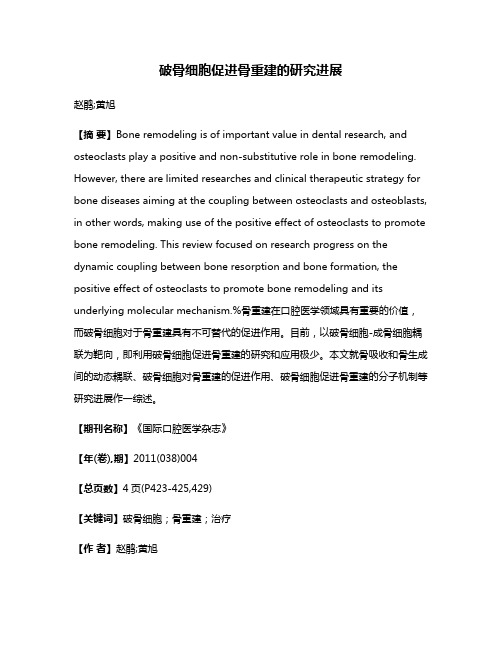
破骨细胞促进骨重建的研究进展赵鹃;黄旭【摘要】Bone remodeling is of important value in dental research, and osteoclasts play a positive and non-substitutive role in bone remodeling. However, there are limited researches and clinical therapeutic strategy for bone diseases aiming at the coupling between osteoclasts and osteoblasts, in other words, making use of the positive effect of osteoclasts to promote bone remodeling. This review focused on research progress on the dynamic coupling between bone resorption and bone formation, the positive effect of osteoclasts to promote bone remodeling and its underlying molecular mechanism.%骨重建在口腔医学领域具有重要的价值,而破骨细胞对于骨重建具有不可替代的促进作用。
目前,以破骨细胞-成骨细胞耦联为靶向,即利用破骨细胞促进骨重建的研究和应用极少。
本文就骨吸收和骨生成间的动态耦联、破骨细胞对骨重建的促进作用、破骨细胞促进骨重建的分子机制等研究进展作一综述。
【期刊名称】《国际口腔医学杂志》【年(卷),期】2011(038)004【总页数】4页(P423-425,429)【关键词】破骨细胞;骨重建;治疗【作者】赵鹃;黄旭【作者单位】浙江大学医学院附属口腔医院修复科,杭州310006;浙江大学医学院附属第一医院口腔科,杭州310003【正文语种】中文【中图分类】Q257骨重建在口腔医学领域具有重要的价值,例如:1)牙种植术后建立种植体骨整合界面以及在应力作用下长期保持骨整合界面的稳定;2)牙列缺失后牙槽骨的进行性吸收和骨质疏松时颌骨骨重建的失衡;3)在正畸矫治牙列不齐的过程中,正畸力对牙槽骨改建的作用;4)在颌骨自身骨、异体骨和骨替代品移植以及引导骨再生和牵张成骨术等治疗过程中,骨的改建;5)颞下颌关节的适应性改建等。
大血藤对破骨细胞活性及成骨细胞增殖分化作用的研究
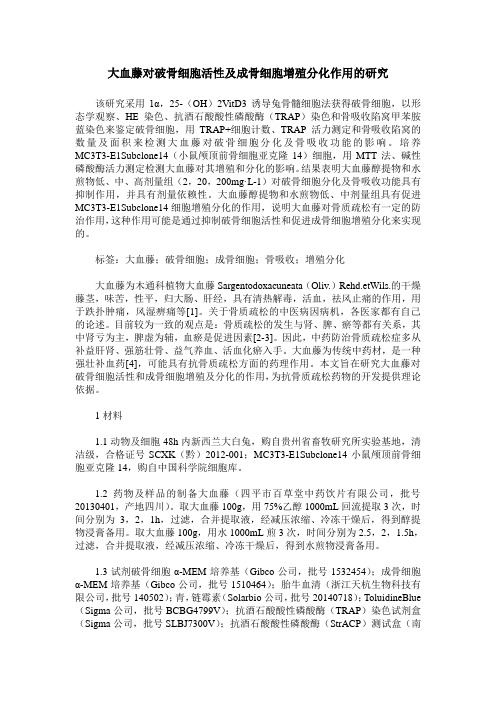
大血藤对破骨细胞活性及成骨细胞增殖分化作用的研究该研究采用1α,25-(OH)2VitD3诱导兔骨髓细胞法获得破骨细胞,以形态学观察、HE染色、抗酒石酸酸性磷酸酶(TRAP)染色和骨吸收陷窝甲苯胺蓝染色来鉴定破骨细胞,用TRAP+细胞计数、TRAP活力测定和骨吸收陷窝的数量及面积来检测大血藤对破骨细胞分化及骨吸收功能的影响。
培养MC3T3-E1Subclone14(小鼠颅顶前骨细胞亚克隆14)细胞,用MTT法、碱性磷酸酶活力测定检测大血藤对其增殖和分化的影响。
结果表明大血藤醇提物和水煎物低、中、高剂量组(2,20,200mg·L-1)对破骨细胞分化及骨吸收功能具有抑制作用,并具有剂量依赖性。
大血藤醇提物和水煎物低、中剂量组具有促进MC3T3-E1Subclone14细胞增殖分化的作用,说明大血藤对骨质疏松有一定的防治作用,这种作用可能是通过抑制破骨细胞活性和促进成骨细胞增殖分化来实现的。
标签:大血藤;破骨细胞;成骨细胞;骨吸收;增殖分化大血藤为木通科植物大血藤Sargentodoxacuneata(Oliv.)Rehd.etWils.的干燥藤茎,味苦,性平,归大肠、肝经,具有清热解毒,活血,祛风止痛的作用,用于跌扑肿痛,风湿痹痛等[1]。
关于骨质疏松的中医病因病机,各医家都有自己的论述。
目前较为一致的观点是:骨质疏松的发生与肾、脾、瘀等都有关系,其中肾亏为主,脾虚为辅,血瘀是促进因素[2-3]。
因此,中药防治骨质疏松症多从补益肝肾、强筋壮骨、益气养血、活血化瘀入手。
大血藤为传统中药材,是一种强壮补血药[4],可能具有抗骨质疏松方面的药理作用。
本文旨在研究大血藤对破骨细胞活性和成骨细胞增殖及分化的作用,为抗骨质疏松药物的开发提供理论依据。
1材料1.1动物及细胞48h内新西兰大白兔,购自贵州省畜牧研究所实验基地,清洁级,合格证号SCXK(黔)2012-001;MC3T3-E1Subclone14小鼠颅顶前骨细胞亚克隆14,购自中国科学院细胞库。
成骨细胞和破骨细胞在骨组织工程学的作用
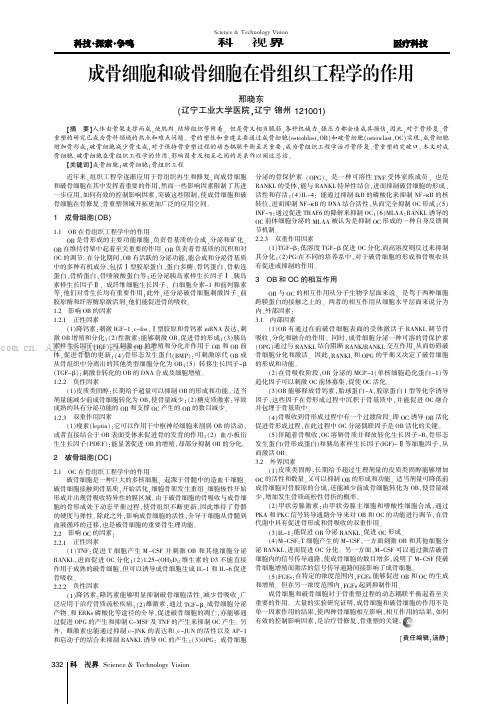
科技视界Science&Technology VisionScience&Technology Vision科技视界近年来,组织工程学逐渐应用于骨组织再生和修复,而成骨细胞和破骨细胞在其中发挥着重要的作用,然而一些影响因素限制了其进一步应用,如何有效的控制影响因素,突破这些限制,使成骨细胞和破骨细胞在骨修复、骨重塑领域开拓更加广泛的应用空间。
1成骨细胞(OB)1.1OB在骨组织工程学中的作用OB是骨形成的主要功能细胞,负责骨基质的合成、分泌和矿化。
OB在维持骨架中起着至关重要的作用。
OB负责着骨基质的沉积和对OC的调节。
在分化期间,OB有活跃的分泌功能,能合成和分泌骨基质中的多种有机成分,包括Ⅰ型胶原蛋白、蛋白多糖、骨钙蛋白、骨粘连蛋白、骨桥蛋白、骨唾液酸蛋白等;还分泌胰岛素样生长因子Ⅰ、胰岛素样生长因子Ⅱ、成纤维细胞生长因子、白细胞介素-1和前列腺素等,他们对骨生长均有重要作用;此外,还分泌破骨细胞刺激因子、前胶原酶和纤溶酶原激活剂,他们能促进骨的吸收。
1.2影响OB的因素1.2.1正性因素(1)降钙素:刺激IGF-1、c-fos、Ⅰ型胶原和骨钙素mRNA表达,刺激OB增殖和分化;(2)性激素:能够刺激OB,促进骨的形成;(3)胰岛素样生长因子(IGF):可刺激OB的增殖和分化并作用于OB和OB前体,促进骨骼的更新;(4)骨形态发生蛋白(BMP):可刺激原代OB或从骨组织中分离出的其他类型细胞分化为OB;(5)转移生长因子-β(TGF-β):刺激非转化的OB的DNA合成及细胞增殖。
1.2.2负性因素(1)皮质类固醇:长期给予超量可以抑制OB的形成和功能。
适当剂量能减少前成骨细胞转化为OB,使骨量减少;(2)糖皮质激素:导致成熟的具有分泌功能的OB和支撑OC产生的OB的数目减少。
1.2.3双重作用因素(1)瘦素(leptin):它可以作用于中枢神经细胞来削弱OB的活动,或者直接结合于OB表面受体来促进骨的发育的作用;(2)血小板衍生生长因子(PDEF):能显著促进OB的增殖,却部分抑制OB的分化。
骨组织工程中成骨、破骨细胞三维空间培养的研究进展
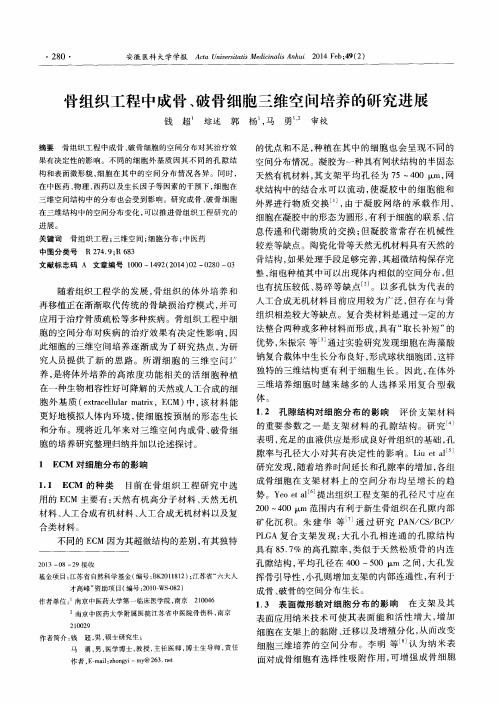
状结构中的结合水可 以流动 , 使凝胶中的细胞能和 外界 进行 物 质 交 换 ¨ J , 由 于凝 胶 网 络 的 承 载 作 用 ,
细胞 在凝 胶 中的形 态为 圆形 , 有利 于 细胞 的联 系 、 信
关键 词
骨组 织工程 ; 三维空间 ; 细胞 分布 ; 中医药
R 2 7 4 . 9; R 6 8 3
钠复合载体中生长分布 良好 , 形成球状细胞团 , 这样
独特 的 三维结 构 更 有 利 于细 胞 生 长 。 因此 , 在 体外 三维 培养 细 胞 时越 来 越 多 的 人 选 择 采 用 复 合 型 载
体。 1 . 2 孔 隙结构 对 细胞 分 布 的 影 响 评价 支架 材 料
1 . 1 E CM 的种 类 目前 在 骨 组 织 工 程 研 究 中选 用的E C M 主要 有 : 天 然有 机 高 分 子材 料 、 天然 无 机 材料 、 人工 合成 有机 材料 、 人工 合成 无机 材料 以及 复
合类材 料 。
矿 化 沉 积 。朱 建 华 等 通 过 研 究 P A N / C S / B C P / P L G A复 合 支 架 发 现 : 大 孔 小孔 相 连 通 的孔 隙 结 构
1 E CM 对 细胞 分布 的影 响
的重要 参 数 之 一 是 支 架 材 料 的 孔 隙 结 构 。研 究 表明, 充 足的血 液供 应是 形成 良好 骨组 织 的基础 , 孔
隙率 与孔径 大 小 对 其有 决 定 性 的影 响 。L i u e t a l _ 5 研 究发 现 , 随着 培养 时 间延长 和孔 隙率 的增 加 , 各组 成 骨 细胞 在 支 架 材 料 上 的空 间分 布 均 呈 增 长 的 趋 势 。Y e o e t a l 提 出组织 工程 支架 的孔径 尺 寸应 在 2 0 0— 4 0 0 m 范 围内有利 于新 生骨 组织 在 孔 隙 内部
成骨细胞如何与破骨细胞共培养
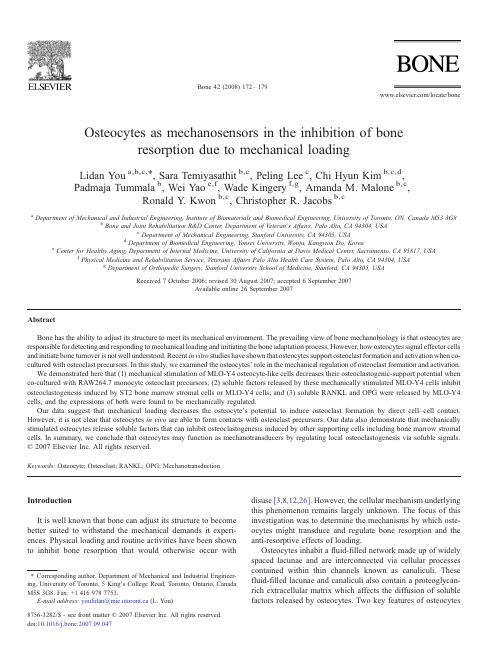
Osteocytes as mechanosensors in the inhibition of boneresorption due to mechanical loadingLidan You a,b,c,⁎,Sara Temiyasathit b,c ,Peling Lee c ,Chi Hyun Kim b,c,d ,Padmaja Tummala b ,Wei Yao e,f ,Wade Kingery f,g ,Amanda M.Malone b,c ,Ronald Y .Kwon b,c ,Christopher R.Jacobs b,caDepartment of Mechanical and Industrial Engineering,Institute of Biomaterials and Biomedical Engineering,University of Toronto,ON,Canada M533G8bBone and Joint Rehabilitation R&D Center,Department of Veteran ’s Affairs,Palo Alto,CA 94304,USAcDepartment of Mechanical Engineering,Stanford University,CA 94305,USA dDepartment of Biomedical Engineering,Yonsei University,Wonju,Kangwon Do,KoreaeCenter for Healthy Aging,Department of Internal Medicine,University of California at Davis Medical Center,Sacramento,CA 95817,USAfPhysical Medicine and Rehabilitation Service,Veterans Affairs Palo Alto Health Care System,Palo Alto,CA 94304,USAgDepartment of Orthopedic Surgery,Stanford University School of Medicine,Stanford,CA 94305,USAReceived 7October 2006;revised 30August 2007;accepted 6September 2007Available online 26September 2007AbstractBone has the ability to adjust its structure to meet its mechanical environment.The prevailing view of bone mechanobiology is that osteocytes are responsible for detecting and responding to mechanical loading and initiating the bone adaptation process.However,how osteocytes signal effector cells and initiate bone turnover is not well understood.Recent in vitro studies have shown that osteocytes support osteoclast formation and activation when co-cultured with osteoclast precursors.In this study,we examined the osteocytes'role in the mechanical regulation of osteoclast formation and activation.We demonstrated here that (1)mechanical stimulation of MLO-Y4osteocyte-like cells decreases their osteoclastogenic-support potential when co-cultured with RAW264.7monocyte osteoclast precursors;(2)soluble factors released by these mechanically stimulated MLO-Y4cells inhibit osteoclastogenesis induced by ST2bone marrow stromal cells or MLO-Y4cells;and (3)soluble RANKL and OPG were released by MLO-Y4cells,and the expressions of both were found to be mechanically regulated.Our data suggest that mechanical loading decreases the osteocyte's potential to induce osteoclast formation by direct cell –cell contact.However,it is not clear that osteocytes in vivo are able to form contacts with osteoclast precursors.Our data also demonstrate that mechanically stimulated osteocytes release soluble factors that can inhibit osteoclastogenesis induced by other supporting cells including bone marrow stromal cells.In summary,we conclude that osteocytes may function as mechanotransducers by regulating local osteoclastogenesis via soluble signals.©2007Elsevier Inc.All rights reserved.Keywords:Osteocyte;Osteoclast;RANKL;OPG;MechanotransductionIntroductionIt is well known that bone can adjust its structure to become better suited to withstand the mechanical demands it experi-ences.Physical loading and routine activities have been shown to inhibit bone resorption that would otherwise occur withdisuse [3,8,12,26].However,the cellular mechanism underlying this phenomenon remains largely unknown.The focus of this investigation was to determine the mechanisms by which oste-ocytes might transduce and regulate bone resorption and the anti-resorptive effects of loading.Osteocytes inhabit a fluid-filled network made up of widely spaced lacunae and are interconnected via cellular processes contained within thin channels known as canaliculi.These fluid-filled lacunae and canaliculi also contain a proteoglycan-rich extracellular matrix which affects the diffusion of soluble factors released by osteocytes.Two key features of osteocytesBone 42(2008)172–179/locate/boneCorresponding author.Department of Mechanical and Industrial Engineer-ing,University of Toronto,5King's College Road,Toronto,Ontario,Canada M5S 3G8.Fax:+14169787753.E-mail address:youlidan@mie.utoront.ca (L.You).8756-3282/$-see front matter ©2007Elsevier Inc.All rights reserved.doi:10.1016/j.bone.2007.09.047as mechanosensors are their ability to detect mechanical stimuli and to send signals to other effector cells that regulate bone formation and resorption[5,6,56,58,59].Dynamic fluid flow is one of the mechanical stimuli that osteocytes experience in vivo with habitual loading[24,25,54].Previous studies have established that this loading-induced dynamic fluid flow is a potent physical signal in the regulation of bone cell metabo-lism[7,16,37,57],yet it is unclear what role it might play in osteocyte-mediated regulation of bone resorption.The effector cells of bone resorption are osteoclasts,which are transient multinucleated cells that arise from hemopoietic cells of the monocyte/macrophage lineage.Osteoclast forma-tion in vivo is thought to be induced by direct cell–cell contact of pre-osteoblastic/stromal cells with monocyte/macrophage osteoclast precursors[4,38].Two key molecules have been found to mediate this interaction:receptor activator of nuclear factor kappa B(NF-κB)ligand(RANKL)(also known as TRANCE,OPGL or ODF)and osteoprotegerin(OPG)(also know as OCIF).RANKL stimulates osteoclast precursors to commit to the osteoclastic phenotype by binding to its receptor (RANK)on the surface of osteoclast precursors.RANKL exists in two forms,a soluble form(sRANKL)and a membrane-bound form thought to be responsible for initiating osteoclast formation[4,52].sRANKL is found in the circulatory system of both animals and human[35,46,53,61].It is thought to play a role in immune response and bone repair[27,34,39,46]and recently has been shown to decrease with endurance physical activity[61].A recent study by Hikita et al.[11]indicated that soluble RANKL can be secreted by primary osteoblasts.How-ever,membrane-bound RANKL was found to be much more efficient in terms of inducing osteoclast formation than soluble RANKL[11].OPG is a decoy receptor that can bind to RANKL and inhibits its binding with RANK.OPG binding to RANKL not only blocks osteoclastogenesis but also decreases the survival of pre-existing osteoclasts.The bone resorption rate is thus affected by the balance of RANKL and OPG[4].Osteoclastogenesis has been shown to be regulated by mechanical loading both in vitro and in vivo[17,19,21,40–43]. Rubin and colleagues[40–43]have shown that dynamic mechanical strain can decrease osteoclast formation by about 50%in primary marrow cultures,and this is mediated through a decrease in RANKL and an increase in eNOS-generated NO in bone marrow stromal cells.OPG expression at both the gene and the protein level has also been shown to be regulated by mechanical stimulation[21,45].A recent study by Kim et al.[21] reported that physiological levels of loading-induced fluid flow decreased osteoclast formation in a co-culture system of marrow stromal cells and osteoclast precursors by decreasing the RANKL/OPG mRNA ratio.Taken together,these studies suggest that osteoclastogenesis in the marrow stroma can be mechanically regulated at the cellular level via the RANKL-OPG-RANK signaling system.However,it is unclear what role osteocytes might play in the mechanical regulation of osteoclastogenesis.Osteocytes have been shown to support osteoclastogenesis when co-cultured with osteoclast precursors[60].Interestingly however,this induction was found to require cell–cell contact since the conditioned media of osteocytes were not able to support osteoclast formation.It is possible that osteocytes near the bone surface or in active resorption pits sense mechanical loading and regulate osteoclast formation via their expression membrane-bound RANKL.However,the opportunity for osteocytes to come in direct contact with monocytic osteoclast precursors is likely to be limited.Thus,another important ques-tion is whether soluble factors released by osteocytes might regulate osteoclast formation supported by stromal cells.In this study we address the potential for mechanical stimu-lation to regulate the ability of osteocytes to support osteoclas-togenesis by direct cell–cell contact with osteoclast precursors and whether the RANKL/OPG signaling axis is the relevant mechanism.Additionally we show that mechanically stimulated osteocytes secrete soluble signals that are able to inhibit the osteoclast formation induced by contact with other cells includ-ing bone marrow stromal cells.Materials and methodsCell cultureThree cell lines were used in this study.MLO-Y4,kindly provided by Dr. Lynda Bonewald(University of Missouri–Kansas City,Kansas City,MO),is an immortalized cell line that has properties very similar to primary osteocytes in terms of morphology and several important molecular osteocyte markers[20]. RAW264.7(ATCC)is a mouse monocyte/macrophage cell line which can differentiate into multinucleated cells with an osteoclastic phenotype that possess the ability to resorb calcified substrates.ST2(Riken,Japan)is a murine bone marrow stromal cell line.These cells can differentiate into osteoblast-like cells given appropriate stimulation and can support osteoclast formation when co-cultured with osteoclast precursors.MLO-Y4cells were cultured on type I rat tail collagen(BD Laboratory)-coated plates inαMEM(GIBCO™)supplemented with5%fetal bovine serum (FBS),5%calf serum(CS),and1%penicillin and streptomycin(PS).RAW264.7 cells were cultured in DMEM(GIBCO™)supplemented with10%FBS and1% PS.ST2cells were maintained inαMEM supplemented with10%FBS and1% PS.All cell lines were maintained at37°C and5%CO2in a humidified incubator. For flow experiments,MLO-Y4cells were cultured on type I rat tail collagen-coated glass slides(75mm×38mm×1mm)48h prior fluid flow exposure at 200,000cells/slide to ensure the80–90%confluence at the time of experiment.Multiple osteoclast formation strategies were employed in this project.Co-culture of MLO-Y4and RAW264.7cells was used to explore the role of osteocytes in the regulation of osteoclastogenesis by direct cell–cell contact. MLO-Y4cells were seeded at500cells/cm2in collagen-coated24-well plates (day0).RAW264.7cells were added at2500cells/cm2at day2and then co-cultured in DMEM containing10%FBS for7days.Pre-osteoblast/stromal cell induced osteoclast formation was similarly performed as described above except that ST2cells were substituted for MLO-Y4cells.For these experiments media were supplemented with10nM1α,25-dihydroxyvitamin D3(Fluka)for RANKL expression and the plates were not collagen coated.In all osteoclastogenesis systems described above,medium was replaced every2or3days.At day7starting from RAW264.7cell plating,cells were fixed and stained for tartrate-resistant acid phosphatase(TRAP)using a leukocyte acid phosphatase kit(385A,SIGMA)as instructed in the product manual.Osteoclasts were identified as TRAP-positive cells containing three or more nuclei(TRAP+ MNCs).These cells were counted using a light microscope with20×objective by 2blinded investigators.Each sample was counted three times,and the average value of these repeats was reported as the TRAP+MNCs number for each sample.To assess osteoclast activity,cell culture was performed as described above for each osteoclastogenesis system except that the substrates were dentine discs (Osteosite™)in96-well plates.The cells were cultured for14days(starting from RAW264.7cell plating).At day15cells were removed from dentine discs using a toothbrush.The dentin discs were then stained with1%toluidine blue for 2min,rinsed in distilled water and air dried.The existence of osteoclast-resorbed lacunae was observed and verified under a light microscope.173L.You et al./Bone42(2008)172–179The effect of soluble factors released by osteocytes on osteoclastogenesis was studied using conditioned medium from MLO-Y4cells.After flow exposure,cell-seeded glass slides were transferred from flow chambers to sterile petri dishes with 15ml fresh media added.At24h post flow,conditioned medium samples were collected from these dishes and added immediately to the co-culture of RAW264.7 and MLO-Y4or ST2cells to replace50%of the original culture medium.The collected conditioned medium was never frozen or allowed to age in any way.This process is repeated every subsequent day until day7(starting from RAW264.7 cell plating)when cultures were stained for TRAP activity.Oscillatory fluid flowOur laboratory has previously shown that oscillatory fluid flow is a potent regulator of bone cell metabolism[2,21,30].A2-h exposure to oscillatory fluid flow was selected as the mechanical stimuli in this study based on a previous experiment where this exposure period was found to maximally impact the RANKL/OPG ratio[21].A previously established flow system was used to apply oscillatory fluid flow in this study[16,31].In brief,flow was driven by a Hamilton glass syringe,which was mounted on and driven by an electromechanical loading device (EnduraTEc).An oscillatory fluid flow pattern with a peak flow rate of27ml/ min was generated which yields a peak sinusoidal wall shear stress of1Pa at1Hz in flow chambers.For all flow experiments,MLO-Y4cells were seeded on collagen-coated slides for2days,and then exposed to the oscillatory fluid flow pattern described above for2h.Cells cultured on slides,placed in flow chambers, but not exposed to flow were the experimental controls.All flow chambers were placed in a CO2incubator for the entire duration of the flow experiment.Quantitative real-time RT-PCR analysis of steady-state mRNA levelsImmediately following the completion of the flow experiment,cell-seeded glass slides were transferred from flow chambers to100-mm sterile petri dishes. Total RNA was extracted from cells using Tri-Reagent(SIGMA).Extracted RNA was used for cDNA synthesis by reverse transcriptase using GeneAmp RNA PCR Core Kit(Applied Biosystems).The cDNA samples were subjected to PCR analysis using Taqman PCR Master Mix and20×primer and probes(Applied Biosystems).Amplifications were then performed using the ABI Prism7900HT Sequence Detection system.The expression of the gene of interest and the housekeeping gene(18S)were simultaneously determined in the same sample.For each sample,mRNA levels for each gene were normalized to18s rRNA levels. Protein quantificationImmediately following the completion of flow exposure,cell-seeded slides were transferred from flow chambers to sterile petri dishes,with15ml of fresh media added,and returned to the incubator.Media samples were collected at2h, 24h,and48h post flow.Supernatant levels of RANKL and OPG were measured using Quantikine Mouse RANKL Immunoassay and Quantikine Mouse OPG Immunoassay,respectively,from R&D systems.Total protein assay was performed using BCA™Protein Assay Kit from Pierce.Statistical analysisFor two sample comparisons,Student's t test was used.To compare observations from more than two groups,ANOV A was used.A significance level of0.05was employed for all statistical analyses.Data were reported as mean±SE. ResultsOsteocytes support osteoclast formation and activation when direct cell–cell contact with osteoclast precursors was allowed It has been shown that osteocytes can support osteoclast formation and activation using co-culture systems of MLO-Y4 cells and spleen/marrow cells[60].As expected MLO-Y4cells can also support osteoclast formation from RAW264.7cells at multiple cell densities and ratios.We found that the co-culture of MLO-Y4cells at1000cells/well and RAW264.7cells at 5000cells/well resulted in maximal osteoclast formation(data not shown).Fig.1shows that tartrate-resistant acid phosphatase (TRAP)-positive cells containing three or more nuclei(TRAP+ MNCs)were formed in this co-culture system at day9and pits were formed on dentine discs after14days of co-culture. Oscillatory fluid flow decreases MLO-Y4cells osteoclastogenic-support potentialTo test whether oscillatory fluid flow exposure would affect the rate of osteoclast formation in the system described above, we seeded the MLO-Y4cells on slides at a density of2×105/ slide for48h and then exposed them to oscillatory fluid flow for 2h.Next,RAW264.7cells were deposited on the slides;cells were then co-cultured and TRAP staining was performed at day 9.We found that2h of flow exposure decreased the TRAP+ MNCs formed in the co-culture by38%(p=0.002,experiment was repeated4times)(Fig.2).Note,to ensure that the observed decrease in osteoclast formation is not due to any potential loss of MLO-Y4cells dislodged by the fluid flow shear stress,BCA total protein assay was conducted on lysed MLO-Y4cells before and after flow.We found no changes in total protein level due to flow(data not reported).Oscillatory fluid flow decreases RANKL/OPG ratio at the mRNA level in MLO-Y4cellsTo investigate the mechanism behind the down-regulation of osteoclastogenesis by oscillatory fluid flow on MLO-Y4cells, we measured the RANKL/OPG ratio at the mRNA level in MLO-Y4cells with or without flow exposure.MLO-Y4cells were cultured on collagen-coated glass slides for2daysand Fig.1.MLO-Y4cells induce osteoclast formation and activation when co-cultured with RAW264.7cells.(A)TRAP+MNCs on24-well plates at day9of co-culturing MLO-Y4cells and RAW264.7cells at500cells/cm2and2500 cells/cm2,respectively.(B)Pits formed on dentine discs at day14after co-culture of MLO-Y4cells and RAW264.7cells at the same cell density as described above.174L.You et al./Bone42(2008)172–179exposed to oscillatory fluid flow for2h.Total RNA was collected at0h,24h,and48h after flow exposure.Quantitative real-time RT-PCR analysis was performed on RANKL,OPG and18s rRNA.At0h post flow,cells subjected to oscillatory fluid flow had significantly higher RANKL(107%increase, p=0.037)and OPG(164%increase,p=0.017)mRNA levels compared to the control groups(Fig.3).As a result,2-h oscillatory fluid flow exposure caused a decrease in RANKL/OPG mRNA ratio by29%(p=0.028).However,at24h and48h post flow,the RANKL/OPG mRNA ratio was found to return to the pre-flow baseline level(data not shown).Osteocytes that are exposed to oscillatory fluid flow release soluble signals that inhibit osteoclast formationWe next investigated the potential role in osteoclastogenesis of soluble signals released by MLO-Y4cells.No TRAP+MNCs were observed when RAW264.7cells were exposed to MLO-Y4 conditioned media for7days(data not shown).This indicates that soluble factors released by osteocytes do not induce osteoclas-togenesis directly as expected given the results of Zhao et al.[60]. However,it is not known whether the soluble factors released by mechanically challenged MLO-Y4cells can affect osteoclasto-genesis supported by contact with another cell type.To determine whether the soluble factors released by mechanically stimulated MLO-Y4cells can regulate osteoclas-togenesis induced by other cells,at24h post flow freshly collected conditioned medium from MLO-Y4cells with or without exposure to oscillatory fluid flow was added to two systems that are known to result in osteoclast formation:(1)co-culture of RAW264.7cells with ST2cells or(2)co-culture of RAW264.7cells MLO-Y4cells.For each group,the experiment is repeated4times(n=4).We observed a decrease of osteoclast numbers formed in both systems:26%(p=0.0005)and31% (p=0.006)(Fig.4),respectively.Oscillatory fluid flow affects RANKL and OPG protein release by MLO-Y4cellsMLO-Y4cells were prepared as described previously.After 2-h oscillatory fluid flow exposure,cell-seeded slides were transferred from flow chambers to sterile petri dishes,and in-cubated for2days.Conditioned medium samples were collected from the culture dishes at multiple time points(2h,24h,and48h post flow)and ELISA was performed to quantify supernatant RANKL and OPG levels.The2-h oscillatory fluid flow decreased the production of sRANKL at both2h(10%,p=0.049)and24h(59%,p= 0.00003)post flow compared to no-flow controls(Fig.5A).We next measured the supernatant OPG level in the conditioned medium from MLO-Y4cells with or without2-h oscillatory fluid flow exposure(Fig.5B).At2h post flow,OPG was significantly increased by60%in cells exposed to2-h oscillatory fluid flow(p=0.0297).At24h post flow,the increase of OPG is 77%greater in the flow group,however,the difference between the flow group and the no-flow control group is notstatistically Fig.3.Cells exposed to2h flow had2-fold greater RANKL and OPG mRNAlevels compared to no-flow control group.The ratio of RANKL/OPG wasdecreased by29%.Total RNA was isolated immediately following the com-pletion of flow experiment.Bars represents means±SEM(n=4for all groups;⁎significant difference between flow group and no-flow group,p b0.05).Fig.2.Osteoclastogenesis in the co-culture of MLO-Y4and RAW264.7cellswas dramatically inhibited by38%due to2h of flow exposure of MLO-Y4cells.Cells were co-cultured for7days.TRAP staining was performed at day9.Osteoclastogenesis was quantified by counting TRAP+MNCs in10randomlychose fields in the center part of slides and values are normalized to controls.The average value corresponding to normalized value1is108cells.Barsrepresents means±SEM(n=4for all groups;p=0.002).Fig.4.TRAP+MNCs formed in two osteoclastogenesis systems:co-culture ofMLO-Y4and RAW264.7cells,and co-culture of ST2and RAW264.7cells.Conditioned medium from MLO-Y4cells exposed to oscillatory fluid flow or noflow was added to these cultures.Oscillatory fluid flow inhibited osteoclastformation in all of these osteoclastogenesis systems.Bars represents means±SEM(n=4for all groups;⁎significant difference between flow group and no-flow group,p b0.05).175L.You et al./Bone42(2008)172–179significant (p =0.068).Power analysis is conducted and the possibility of type II error is less than 0.6%.DiscussionIt has been shown that mechanical loading has the ability to suppress bone resorption [3,8,12,26].However,the cellular mechanism that underlies this anti-resorptive effect is not clear.Osteocytes are the most abundant cell type in bone.Their location,embedded in the mineralized bone tissue,and demon-strated mechanosensitivity suggest that they function as cellular mechanotransducers [5,23].Furthermore,recent studies have shown that osteocytes can support osteoclast formation and activation by direct cell –cell contact with osteoclast precursors [10,60].Thus,the purpose of this study was to determine if and by what mechanism osteocytes might regulate osteoclast for-mation due to mechanical loading.The first experiment in this study was to determine if mechanical stimulation of osteocytes might affect their potential to induce osteoclast formation by direct cell –cell contact.Pre-viously Zhao et al.[60]demonstrated that MLO-Y4osteocytes can induce osteoclastogenesis when co-cultured with osteocyte precursors.We extended this finding by showing that mechan-ical stimulation has the effect of diminishing this induction.Our results showed that 2h of flow exposure inhibited osteoclast induction by MLO-Y4cells by 38%(Fig.2).One concern with the concept of osteocyte-mediated regu-lation of osteoclast formation is that osteocytes have limited physical contact with the hemopoietic osteoclast precursors in vivo —osteocytes are deeply embedded in bone matrix and do not appear to contact bone marrow except perhaps the few osteocytes adjacent to a bone surface [18].Given the fact that osteoclast formation in vivo is thought to require cell –cell contact between monocyte osteoclast precursors and supporting cells (e.g.,pre-osteoblasts or bone marrow stromal cells),regulation of osteoclastogenesis directly via physical contacts between osteocytes and osteoclast precursors would be unlikely except on the resorption surface where osteocyte processes might be exposed.We therefore conducted an experiment to determine if mechanically stimulated osteocytes might release diffusible factors capable of regulating osteoclastogenesis at a distance.We exposed co-cultures of ST2stromal cells and RAW264.7monocytes to the conditioned media of osteocytes exposed to fluid flow.We observed a 31%decrease in osteoclast formation relative to the conditioned media from no-flow controls.This finding is consistent with osteocytes acting as mechanosensors and mediating stromal cell induced osteoclas-togenesis via diffusible factors.A similar result was obtained for osteocyte induced osteoclastogenesis (26%decrease).Thus,our data suggest that mechanically challenged osteocytes may affect the osteoclast-inducing capacity of supporting cells (stromal cells,osteoblasts,or osteocytes)via soluble factors resulting in changes in the supporting cells'local chemical environment.Note that the fluid flow to which osteocytes were exposed in this study is 2h.Several others studies [1,16,50,51,57]have shown that mechanical stimuli at this duration can induce many changes in markers of bone formation/resorption in bone cells.We expect that with longer flow exposure times,the bone resorption inhi-bition effect from mechanical loading might be further en-hanced.The CM used in this study was from MLO-Y4cells seeded on glass slides immersed in 15ml medium to ensure that the cells remained covered during the subsequent 24-h post flow incubation.Due to this dilution the concentration of our CM (ratio between cell numbers and medium volume)is relatively low compared to other studies of this type.Nevertheless,we observed an inhibitory effect of the CM on the osteoclastogen-esis,suggesting that with higher concentration of this CM,the inhibition effect would be greater.Taken together these obser-vations suggest that the mechanical regulation of bone resorp-tion may occur via osteocyte regulation at a distance away from the actual site of osteoclastogenesis potentiated by other cell types.Furthermore,it is also possible that the soluble factors released by osteocytes might affect the osteoclast-support capacity of osteoblastic cells.To explore the mechanism by which the anti-osteoclastogenic effects of osteocytes occur,we examined the key signaling molecules that regulate osteoclastogenesis,RANKL and OPG.Consistent with a previous study [60],we observed that osteocytes express RANKL and OPG at both the mRNA and protein levels.The RANKL/OPG mRNA ratio decreased immediately after flow.However,this decrease is lost with time and recovered to pre-flow baseline level at 24h and 48h.This result is consistent with our previous study on ST2cellsFig.5.(A)Two hours flow exposure decreased the amount of sRANKL released by MLO-Y4cells by 10%at 2h post flow and 60%at 24h post flow.(B)MLO-Y4cells exposed to 2-h flow released a greater amount of OPG compared with MLO-Y4cells exposed to no flow at 2h post flow (60%)and 24h post flow (77%).Bars represents means±SEM (n =4for all groups;⁎significant difference between flow group and no-flow group,p b 0.05).176L.You et al./Bone 42(2008)172–179[21].It appears that the effect of mechanical loading on RANKL/ OPG mRNA ratio in bone cells occurs immediately and when the stimulus is removed the signaling system is reset.In vivo stimulation would be continuous and although our data do not address this question directly,we would anticipate that this resetting would not occur and the decrease in RANKL/OPG mRNA ratio would be maintained.OPG and sRANKL protein released by MLO-Y4cells was then measured at2h and24h post flow.Two hours of flow exposure dramatically increased OPG message and protein (Figs.3and5),suggesting that the inhibitory effect of flow might be due to an upregulation of OPG.However,at24h post flow,OPG protein level is not statistically significant different (p=0.068)from the non-flow group.We speculate that in addition to OPG,other soluble factors such as TGF-beta and VEGF may also contribute to the decrease in osteoclastogenesis induced by CM from MLO-Y4cells.Indeed,there is some evidence in the literature to support this view.For example, studies have shown that mechanical stimulation of osteocytes can upregulate TFG-beta and that osteocytes inhibit osteoclastic bone resorption through TGF-beta[10].Furthermore,it has been found that fluid shear can increase TGF-beta in osteo-blastic cells[32,44].VEGF has been found to be increased after MLO-Y4cells are exposed to fluid flow[49],and VEGF can increase osteoclastogenesis in vitro[47].Taken together with our findings,these results suggest that the inhibitory effect of MLO-Y4cell CM on induced osteoclastogenesis involves one or more signaling molecules and may or may not involve OPG.In non-osteocyte cell types RANKL mRNA has been reported to be downregulated with mechanical stimulation [21,41–43].Paradoxically,we observed an upregulation of RANKL mRNA with stimulation in osteocytes,suggesting that RANKL mechanoregulation at gene level in osteocytes might be different from other cell types.Furthermore,we observed a decrease in sRANKL protein under the same flow conditions. The mechanism responsible for this discrepancy is not clear, however,it is likely to involve the recently uncovered and only partially understood complex RANKL regulation mechanism [13,48].Three isoforms of RANKL have been reported to occur as alternative splice variants(denoted RANKL1/2/3).Our PCR primers were designed to detect exon526,common to all three isoforms.In vivo sRANKL protein can be the translational product of RANKL3mRNA,which only contains an extracel-lular domain[14].Thus,flow might increase the RANKL1and RANKL2expression but decrease RANKL3expression so that the message level of RANKL is increased but the sRANKL protein as the translational product of RANKL3is decreased. Alternatively sRANKL may be formed from the enzymatic cleavage of the extracellular domain of a full-length RANKL [15,29,34,55].And the flow induced decrease of sRANKL may be the result of the flow exerted posttranscriptional or enzymatic effect on MLO-Y4cells.RANKL protein has been reported in bone cells in vivo[36] and in vitro[60].However,data on whether bone cells release soluble RANKL are difficult to interpret.Kusumi et al.[28] reported that normal human osteoblasts release sRANKL and this release was downregulated dramatically by applying con-tinuous tensile strain to the cells.Ikeda et al.[14]found RANKL3 mRNA in ST2and MC3T3-E1cells.Nevertheless,many studies suggest bone cells either do not release or release very limited levels of soluble RANKL[9,22,33,45,60].In our study,we observed that MLO-Y4cells released sRANKL into the media, and this was downregulated with mechanical stimulation. However,this released sRANKL was not able to directly induce osteoclast formation.Similarly,previous experiments showed that conditioned media from osteoblasts/stromal cells were not able to promote osteoclast formation.Thus,our findings suggest that RANKL dynamics in osteocytes is consistent with that reported for other types of bone cells,and the levels of sRANKL produced by bone cells are not able to induce osteoclastogenesis.The existence of the pericellular matrix in the space surrounding osteocytes could potentially affect the diffusion of the soluble factors released by osteocytes including sRANKL and OPG.The molecular weight of sRANKL and OPG has been reported as24kDa and60kDa,respectively.The tracer horseradish peroxidase(44kDa,6nm)has been found to diffuse through the osteocyte pericellular matrix[7]suggesting that indeed sRANKL and OPG are able to move through the lacunar canalicular system.Although not the primary focus of this investigation,this work has certain implications for potential mechanisms whereby resorbing osteoclasts are targeted to sites where bone remodeling is required.We found that conditioned media from mechanically loaded osteocytes were able to inhibit osteoclast formation induced by cell–cell contact between ST2cells and RAW264.7 cells.Thus,the physiologic condition(i.e.,bone is regularly being mechanical loaded)may be a homeostatic equilibrium between baseline sRANKL and anti-resorptive factors locally secreted by osteocytes.In the absence of mechanically stimu-lated osteocytes the balance would locally favor osteoclast formation and activation.This would provide a compelling mechanism for the removal and replacement of dead osteocytes. In addition,our study is the first to demonstrate that osteocytes release diffusible chemical signals that regulate the resorptive potential in their local surroundings in response to changes in the physical signals they experience.Specifically,our results sug-gest that osteocytes under normal loading create a local chemical environment that is not osteoclastogenic.However,osteocytes that are not exposed to the appropriate physical signals shift the balance of secreted factors to favor resorption.Thus,in local regions of low flow(e.g.,local areas of damaged bone tissue), osteocytes would enter a state of disuse and signal increased osteoclast formation.Furthermore,the changes in the local chemical environment surrounding the osteocyte in the absence of loading might also serve to attract and guide active osteoclasts to replace regions of damage and disuse.In summary,we have demonstrated that mechanical stimu-lation may regulate osteoclast formation via osteocytes.Oscil-latory fluid flow has been show to decrease osteoclast formation induced by cell–cell contact between osteocytes and osteoclast precursors.Furthermore,our results show that the osteoclast support capacity of non-osteocytes is modulated by soluble factors released by mechanically challenged osteocytes.This finding supports a novel osteoclast regulation mechanism.177L.You et al./Bone42(2008)172–179。
体外成骨细胞和破骨细胞联合培养方式的研究进展
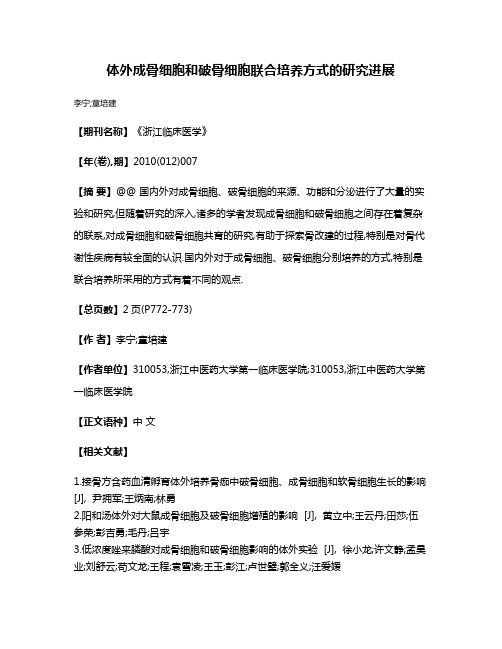
体外成骨细胞和破骨细胞联合培养方式的研究进展
李宁;童培建
【期刊名称】《浙江临床医学》
【年(卷),期】2010(012)007
【摘要】@@ 国内外对成骨细胞、破骨细胞的来源、功能和分泌进行了大量的实验和研究,但随着研究的深入,诸多的学者发现成骨细胞和破骨细胞之间存在着复杂的联系,对成骨细胞和破骨细胞共育的研究,有助于探索骨改建的过程,特别是对骨代谢性疾病有较全面的认识.国内外对于成骨细胞、破骨细胞分别培养的方式,特别是联合培养所采用的方式有着不同的观点.
【总页数】2页(P772-773)
【作者】李宁;童培建
【作者单位】310053,浙江中医药大学第一临床医学院;310053,浙江中医药大学第一临床医学院
【正文语种】中文
【相关文献】
1.接骨方含药血清孵育体外培养骨痂中破骨细胞、成骨细胞和软骨细胞生长的影响[J], 尹拥军;王炳南;林勇
2.阳和汤体外对大鼠成骨细胞及破骨细胞增殖的影响 [J], 黄立中;王云丹;田莎;伍参荣;彭吉勇;毛丹;吕宇
3.低浓度唑来膦酸对成骨细胞和破骨细胞影响的体外实验 [J], 徐小龙;许文静;孟昊业;刘舒云;苟文龙;王程;袁雪凌;王玉;彭江;卢世璧;郭全义;汪爱媛
4.低浓度唑来膦酸对成骨细胞和破骨细胞影响的体外实验 [J], 徐小龙;苟文龙;王程;袁雪凌;王玉;彭江;卢世璧;郭全义;汪爱媛;许文静;孟昊业;刘舒云;
5.补骨脂单体成分对体外培养成骨细胞和破骨细胞分化的影响 [J], 柴丽娟;樊娜;王虹;张晗;王少峡;苗琳;毛浩萍;周昆
因版权原因,仅展示原文概要,查看原文内容请购买。
骨碎补对成骨细胞和破骨细胞作用的研究进展

3 8一
盛 华 刚骨 碎 补 对 成 骨 细 胞 和 破 骨 细 胞 作 用 … ・ ・
增殖作用。但当浓度高于 1 . 0 g / L时几乎无此作用 , 这可能与药物本身具有一定 的细胞毒性有关。唐琪 等 研究表明骨碎补水、 醇提 取液 中分别存 在有较 高 活性 的促 小 鼠成 骨细胞 MC 3 T 3一E 1 基 质矿 化 的物
S h e n g Hu a g a n g
( P h a r m a c y S c h o o l o f S h a n d o n g U n i v e r s i t y o f T r a d i t i o n a l C h i n e s e Me d i c i n e , S h a n d o n g J i n a n 2 5 0 3 5 5 )
Ab s t r a c t T h e r e s e a r c h s u r v e y o f Dr y n a r i a e Rh i z o ma o n o s t e o b l a s t s a n d o s t e o c l a s t s wa s r e v i e we d t o p r o v i d e a n e w w a y f o r t h e f u he t r r e s e a r c h . D r y n a r i a e R h i z o ma c o u l d p r o mo t e p r o l i f e r a i t o n o f o s t e o b l a s t s , i n h i b i t e o s t e o c l a s t s f u n c ・ t i o n . h e T me c h a n i s m w a s r e l a t e d t o r e g u l a i t o n o f v a io r u s b o n e p r o t e i n nd a mRN A e x p r e s s i o n .Dr y n a r i a e R h i z o ma
细胞共培养技术在骨组织生物学中的应用
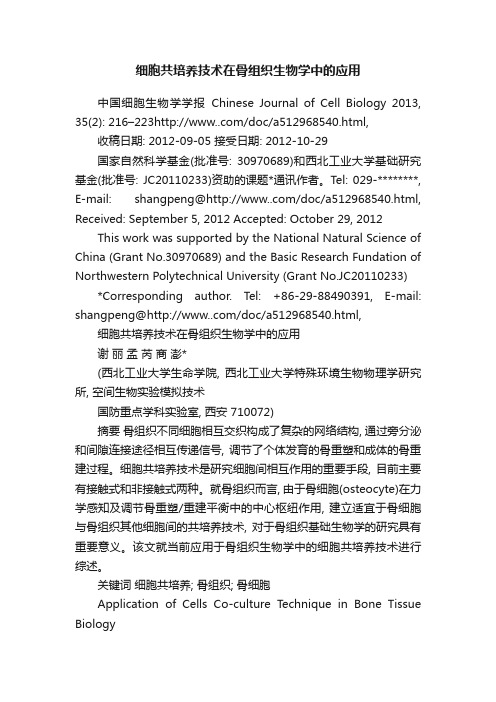
细胞共培养技术在骨组织生物学中的应用中国细胞生物学学报Chinese Journal of Cell Biology 2013, 35(2): 216–223/doc/a512968540.html, 收稿日期: 2012-09-05 接受日期: 2012-10-29国家自然科学基金(批准号: 30970689)和西北工业大学基础研究基金(批准号: JC20110233)资助的课题*通讯作者。
Tel: 029-********, E-mail: shangpeng@/doc/a512968540.html, Received: September 5, 2012 Accepted: October 29, 2012 This work was supported by the National Natural Science of China (Grant No.30970689) and the Basic Research Fundation of Northwestern Polytechnical University (Grant No.JC20110233) *Corresponding author. Tel: +86-29-88490391, E-mail: shangpeng@/doc/a512968540.html, 细胞共培养技术在骨组织生物学中的应用谢丽孟芮商澎*(西北工业大学生命学院, 西北工业大学特殊环境生物物理学研究所, 空间生物实验模拟技术国防重点学科实验室, 西安 710072)摘要骨组织不同细胞相互交织构成了复杂的网络结构, 通过旁分泌和间隙连接途径相互传递信号, 调节了个体发育的骨重塑和成体的骨重建过程。
细胞共培养技术是研究细胞间相互作用的重要手段, 目前主要有接触式和非接触式两种。
就骨组织而言, 由于骨细胞(osteocyte)在力学感知及调节骨重塑/重建平衡中的中心枢纽作用, 建立适宜于骨细胞与骨组织其他细胞间的共培养技术, 对于骨组织基础生物学的研究具有重要意义。
成骨细胞、破骨细胞与骨折愈合的相关性研究进展

成骨细胞、破骨细胞与骨折愈合的相关性研究进展骨折是骨科临床最常见的疾病,指骨的力学完整性丧失,同时也包括局部软组织与血管的损伤。
骨折愈合是指对骨组织创伤局部的修复,是一个连续不断的过程,一面清除破坏,一面再生修复,其本质就是骨折断端发生的骨重建塑型过程。
由成骨细胞主导的骨形成与由破骨细胞主导、成骨细胞和破骨细胞共同调控的骨吸收在骨重建过程中起重要作用,但有关两者与骨折愈合的关联性未见系统报道。
本文以细胞生物学功能为出发点,从成骨细胞与破骨细胞对骨形成、骨吸收的影响入手对成骨/破骨细胞与骨折愈合的关联性做系统性综述。
[Abstract] Fracture is the most common disease in the orthopedics,the mechanical integrity of phalanx is lost,and the damage of local soft tissue and blood vessels is also included in fracture. Fracture healing refers to the local repair of bone tissue trauma,and is a continuous process,with removing the damage on the one hand and regeneration and repair on the other hand. Its essence is the bone reconstruction and plastic process occurred at fracture ends. Bone formation dominated by osteoblasts and bone resorption which is dominated by osteoclasts,co-regulated by osteoblasts,play an important role in bone remodeling. But the association between the two and bone healing is not reported. In this paper,the relationship between osteoblasts/osteoclasts and bone healing was systematically reviewed based on the influence of osteoblasts and osteoclasts on bone formation and bone resorption,with cell biology function as a starting point.[Key words] Osteoblasts;Osteoclasts;Fracture healing;Bone formation;Bone resorption骨折是骨科臨床最常见、发生率最高的疾病,骨组织属于可再生性组织,其修复进程是一个复杂的生理过程,且影响因素众多,不仅受患者自身因素及环境因素的影响,也受微观性因素如细胞因子、体细胞、内分泌因素的影响。
补骨脂对成骨细胞和破骨细胞增殖分化的影响研究进展
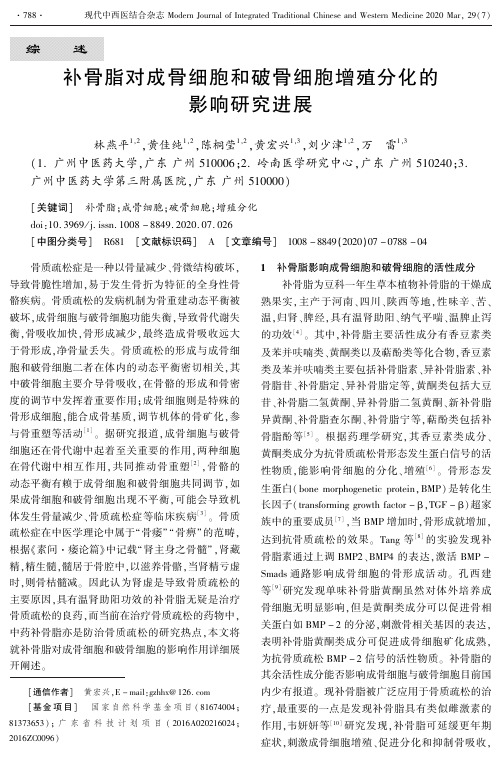
的药性ꎬ使其对成骨细胞的生长造成程度不同的影
3 补骨脂对破骨细胞增殖、分化的影响
响ꎬ杨健等
[11]
通过提取不同来源、不同炮制方法的
补骨脂的有效成分还能够抑制破骨细胞的形
补骨脂煎液培养人成骨肉瘤细胞ꎬ以细胞的增殖、
成ꎬ维持骨形态ꎮ 章文娟等 [19] 使用核因子 κB 受体
OTC、ALP 活性、Ca2 + 的释放及矿化结节的形成为指
[中图分类号] R681 [文献标识码] A [文章编号] 1008 - 8849(2020)07 - 0788 - 04
骨质疏松症是一种以骨量减少、骨微结构破坏ꎬ
1 补骨脂影响成骨细胞和破骨细胞的活性成分
导致骨脆性增加ꎬ易于发生骨折为特征的全身性骨
补骨脂为豆科一年生草本植物补骨脂的干燥成
疗ꎬ最重要的一点是发现补骨脂具有类似雌激素的
作用ꎬ韦妍妍等 [10] 研究发现ꎬ补骨脂可延缓更年期
症状ꎬ刺激成骨细胞增殖、促进分化和抑制骨吸收ꎬ
现代中西医结合杂志 Modern Journal of Integrated Traditional Chinese and Western Medicine 2020 Marꎬ 29(7)
及苯并呋喃类、黄酮类以及萜酚类等化合物ꎬ香豆素
胞和破骨细胞二者在体内的动态平衡密切相关ꎬ其
类及苯并呋喃类主要包括补骨脂素、异补骨脂素、补
中破骨细胞主要介导骨吸收ꎬ在骨骼的形成和骨密
骨脂苷、补骨脂定、异补骨脂定等ꎬ黄酮类包括大豆
度的调节中发挥着重要作用ꎻ成骨细胞则是特殊的
苷、补骨脂二氢黄酮、异补骨脂二氢黄酮、新补骨脂
81373653 ) ꎻ 广 东 省 科 技 计 划 项 目 ( 2016A020216024ꎻ
- 1、下载文档前请自行甄别文档内容的完整性,平台不提供额外的编辑、内容补充、找答案等附加服务。
- 2、"仅部分预览"的文档,不可在线预览部分如存在完整性等问题,可反馈申请退款(可完整预览的文档不适用该条件!)。
- 3、如文档侵犯您的权益,请联系客服反馈,我们会尽快为您处理(人工客服工作时间:9:00-18:30)。
Me d i c i n e , F u z h o u 3 5 0 1 2 2 , f u j i  ̄, C h i n a
ABS TRACT Os t e o c l a s t s a n d o s t e o b l a s t s a r e n o t e x i s t a l o n e, w h i l e c o mmu n i c a t i n g wi t h e a c h o t h e r t h r o u g h d i r e c t c o n t a c t , d i f f u s i b l e p a r a c r i n e f a c t o r s a n d c e l l — b o n e ma t r i x i n t e r a c t i o n . Co — c u l t u r e s y s t e m o f o s t e o b l a s t w i t h o s t e o c l a s t , i n c l u d i n g d i r e c t C O —
骨 细胞 共 培 养 的 一 个 新 的 应 用 方 向 , 将 是 应 用 于软 骨 下骨 重建 功 能 活 动 的探 讨 以 及 中 西 药干 预 骨 性 关 节 炎 的研 究 。 【 关键 词】 成骨细胞 ; 破骨细胞 ; 共培养体 系; 骨重 建 ; 药理 作 用
c u l t u r e a n d i n d i r e c t C O — c u l t u r e . I t s h o u l d b e a c c o r d i n g t o t h e r a t i o o f o s t e o c l a s t s a n d o s t e o b l a s t s u n d e r t h e p a t h o l o g y, c h o o s i n g
t h e s a me s p e Nhomakorabea i e s . C o mp a r e d wi t h l o n e l y c u l t u r e o f o s t e o b l a s t s o r o s t e o c l a s t s , c o — c u l t u r e s y s t e m i s mu c h c l o s e r t o t h e mi c r o e n v i —
D oI : 1 0 . 3 9 6 9  ̄. i s s n . 1 0 0 3 — 0 0 3 4 . 2 0 1 3 . 0 4 . 0 2 2
Re s e a r c h p r o p r e s s o f C O — c u l t u r e s y s t e m o f o s t e o b l a s t wi t h o s t e o c l a s t a n d i t s a p p l i c a t i o n s L / A 0 Na i — s h u n. C HE N We n 一
r o n me n t i n v i v o . I t b e n e i f t s t o e x p l a i n t h e i n t e r a c t i o n s b e t w e e n o s t e o b l a s t s a n d o s t e o c l a s t s , e x p l o i r n g mo l e c u l a r c o mmu n i c a t i o n i n b o n e d i s e a s e s . I t w a s ma i n l y u s e d t o i n v e s t i g a t e t h e p h a r ma c o l o g i c a l me c h a n i s m o f h e r b l a a n d w e s t e r n me d i c i n e i n b o n e r e —
( 1 . 福建中医药大学 , 福建 福 州 3 5 0 1 2 2 ; 2 . 福 建 中 西 医结 合 研 究 院 , 福 建 福 州 3 5 0 1 2 2 )
【 摘要 】 成骨细胞与破骨 细胞并非孤立存在 , 两种细胞存在直接接触 、 分泌旁分泌 因子、 细胞 与骨基质 3种相互
中国骨伤 2 0 1 3年 4月第 2 6卷第 4期 C h i n a JO  ̄ h o p T r a u ma , Ap r . 2 0 1 3, Vo 1 . 2 6 , N o . 4
・
3 4 9・
・
综 述 ・
成骨细胞与破骨细胞共培养及其应用研究进展
廖 乃顺 , 陈文 列 1 , 2 , 黄云梅 , 陈赛 楠
,
肌 NG Y u n — m e i , a n d C H E NS a i — n a I t .
A c a d e m y o fI n t e g r a t i v e Me d i c i n e ,
U n i v e r s i t y fT o r di a t i o n a l C h i n e s e
细胞 的 比例 选 用 种 属 来 源 一 致 的 细胞 。 目前 该 技 术 主 要 用 于探 讨 药 物 防 治骨 质 疏 松 症 的 作 用机 制 , 已有 淫 羊 藿 、 三七、 补 骨脂 、 雷 奈 酸锶 等 既促 进 成 骨 细胞 骨 形 成 , 又抑 制 破 骨 细 胞 骨 吸 收 活 性 的 双 重 药理 作 用 研 究 等报 道 。成 骨 细胞 与 破
作用。 成 骨 细胞 与 破 骨 细 胞 共 培 养技 术 有 直接 接 触 式 、 间接 接 触 式 2类 方 式 , 它 能 最 大程 度 地 模 拟 体 内微 环 境 , 有 利 于 研 究 两 细胞 间的 相 互 作 用 , 探 讨 两者 失 衡 在 骨 质 疏松 症 等 骨代 谢 疾 病 形 成 中的 作 用 ; 细胞 共 培 养应 根 据 病 理 状 态 下 两
